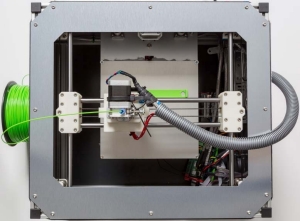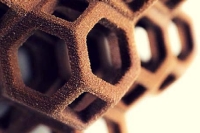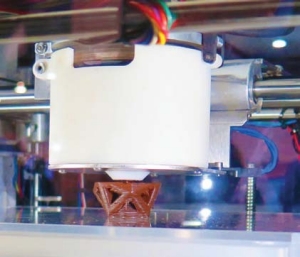3D Printing to Expand in the Consumer Market

By Lisa Jancarik
The International Consumer Electronics Show (International CES) occurs annually in Las Vegas and showcases the latest prototypes consumers can look for in coming years. The 2015 show that concluded in January expanded the amount of space allotted to 3D printers from 7200 square feet to nearly double that amount of exhibit space. This year’s 57 vendors needed that kind of elbow room. For the first time, some vendors exhibited 3D-printed food and clothing, and many more companies displayed models targeted at hobbyists and people who would put 3D printers to personal use.
Show planners had reason to expect exhibits of these devices to draw visitors: sales of 3D printers were estimated to reach $76 million in revenue in 2014, a 43 percent increase over 2013 sales, according to the more recent U.S. Consumer Electronics Sales and Forecast report published by the Consumer Electronics Association (CEA).
Smaller and Cheaper
According to Karen Chupka, senior vice president of International CES and corporate business strategy, CEA, “With huge advancements in digital technology, 3D printers are moving toward more compact units that are more suitable for consumers and capable of printing a variety of consumer goods, from toys and electronics to clothing, shoes and even food.”
This year, 3D Systems designed its CES booth around the theme “the home of now.” The company’s CEO, Avi Reichental, declared 2015 the year that 3D printing becomes mainstream.
Fashion featured heavily into the vendor’s display, with printed jewelry, bags and shoes. Reichental sported his own custom 3D-printed watch band. The company also exhibited leisure equipment, including customized skateboards and printed ping pong paddles and balls. Some of this gear was printed using the 3D Systems’ Ekocycle, a 3D printer developed in partnership with Coca-Cola, which uses PET plastic made from recycled soda bottles. This booth also featured some 3D-printed food, described below.
Capturing Your Style in 3D
Airwolf 3D earned plenty of attention at the show with the exhibit of a 3D-printed outfit. The latest printer offered by this company can work with 25 types of materials. Airwolf lists each of the materials used for the dress, shoes, necklace, headband, phone case and bag. Although plastic resins already familiar to industry insiders make up much of the construction, nylon and metals like copper fill and stainless steel fill make the complete printed fashion look possible.
Once a consumer’s 3D-printed look is complete, Artec’s Shapify can now capture it in a 3D-printed figure. The Shapify booth is like a photo booth that creates a plastic figure from a person’s image instead of a strip of photos. When a person steps into the center of the round booth, he or she is scanned by four scanners that rotate around him or her. This part of the process takes 12 seconds. Then, the printable model is created from a plastic powder in about 15 minutes. If a customer prefers to use a different 3D printer, the scanned data can be transferred to another device. Shapify is calling these full-color, six-inch models “Shapies.” The vendor hopes to introduce these booths to public spaces where crowds naturally gather, like department stores and even airports.

3D Snacktime
This year, CES visitors to the XYZPrinting booth could sample cookies printed on the company’s new Food Printer. The unit’s dimensions are about the size of an espresso machine, and it features a touch screen. It also offers a USB port for users to upload their own cookie designs if none of the printer’s preset choices suit them. XYZPrinting worked with a food specialist to develop its recipe for dough that the device’s nozzles can print into uncooked shapes. The resulting cookies or decorations for cakes need to be baked before they can be eaten.

Food printing technology has another major player, 3D Systems’ ChefJet’s CocoJet, developed in partnership with familiar household brand, The Hershey Company. 3D Systems has some clout on the professional food circuit because it also partners with the Culinary Institute of America, which introduces prestigious chefs to food printing. ChefJet offers professional users the means to create interlocking candies, cake supports and sculptures made from sugar.
3D Printing and Consumers
3D printing has worked with design software to produce resin models of products for years. These have had exquisite detail and even moving parts. These designs would have to be manufactured from appropriate materials when the design process was complete. Small businesses could outsource this aspect of design, but consumers had almost no access to this capability. 3D printing companies are now aggressively pursuing the the consumer market.
Among the more consumer-minded units displayed this year is the Polar 3D printer. Its most striking feature is that instead of having a moving nozzle for its filaments, the nozzle stays in a fixed location and the build platform moves underneath it. This design allows a very small machine to create objects up to six inches high, quite large for its size. Size and price (around $800) for this device make it a more reasonable desktop device for the home office.
Other 3D printers are already on the market for several hundred dollars and are even available through consumer outlets like Amazon. With smaller and less expensive models now or soon to be available in 2015, hobbyists have some access to 3D printing previously only reasonable for larger organizations.